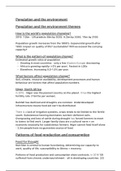Summary
Summary Population and the environment
These notes provided a detailed insight into the topic of Population and the environment. This is perfect for an AQA Geography A Level student. This file breaks down the content in order for it to be fully absorbed. It finds the perfect balance between bullet points, images, graphs, tables and in d...
[Show more]




